Table of Contents
What Is a Hook?
A hook (or narrative hook) is the literary technique of creating an enticing beginning—the very first line or opening of a story—designed to capture readers’ interest. There are many different types of hooks, but a strong hook will grab readers, usually by throwing them into the middle of some dramatic action or by generating curiosity about an intriguing character, unusual situation, or important question.
Meet One of Your New Instructors
Why Is a Good Hook Important?
The purpose of a hook sentence (or scene) is to grab attention and give your reader a reason to invest their time and energy into your writing. The perfect hook will make sure your reader’s mind stays focused on your piece of writing, allowing them to be fully immersed in the argument of a persuasive essay or the fantasy world of a novel. Hooks are crucial in all types of writing: Both fiction writing (short stories and novels of all genres) and nonfiction writing (academic writing, such as research papers, as well as narrative essays) benefit from an exciting opening.

- A hook. Write a strong opening sentence capturing readers’ attention.
- A topic. Tell readers about the focus of your essay.
- A thesis. State your opinion on the topic.
Essays and college papers are not alone in hooks. Fiction writers, copywriters, bloggers, screenwriters, and other men of letters use this instrument to gain our interest and influence our decisions. Did you hear about David Ogilvy and his timeless lessons to writing and standing out? He’s a true genius of hooks and persuasion!
Essay hooks can be difficult to generate, especially if you are still in the process of thesis clarification. The first step toward writing an eye-catching opening for your essay would be answers to these questions:
- What is the type of your essay?
- What writing style and tone do you need to use?
- Who is your intended audience?
- What text structure do you need to establish?
A PRO TIP: Write a hook and introduction after you’ve finished the whole essay. It will help to clarify a thesis and understand what type of hooks would fit your work better.
To get a better idea of what a terrific introduction looks like, watch the video tutorial from James, who defines essay hooks as grabbers.
Essay Hooks Ideas
So, what types of opening lines can you use as a good hook for an essay?
1) Literary Quotes
This type of hooks works for essays about writers, literature phenomena, books, etc. Start your essay with a quote from books you review, and it will establish your authority as a writer.
Examples:

2) Quotes From Famous People
To support your argument and create a lip-smacking hook for your essay, start it with a quote from famous people. But make sure it’s relevant to your topic and thesis.
Examples:
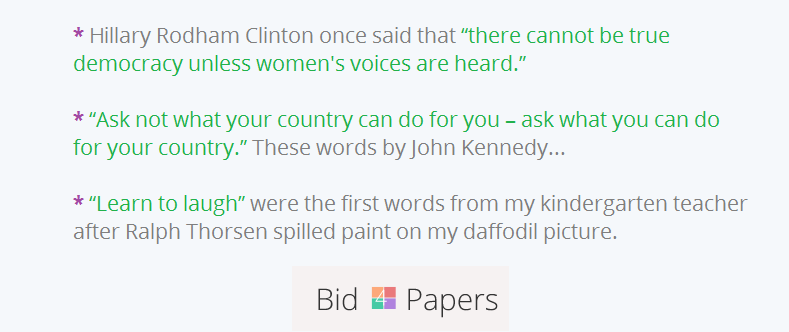
That’s all well and fine but…
Some teachers consider this type of essay hooks too general and overused. They discourage college papers started or finished with words of influencers, not students themselves. So, if you decide to use such a hook, find a rare yet relevant quote. Don’t copy-paste the first available saying from top quotations websites.
3) Common Misconception
You may start your introduction with a statement about a commonly accepted truth being false. That will intrigue your audience and encourage them to keep on reading.
Examples:
- “Most Americans mistakenly believe that all rice is essentially the same.”
- “Most coffee addicts would tell you their favorite drink comes from a bean, but they are wrong. Coffee is made from a seed called a bean.”
4) Anecdotes
“An anecdote is a little story designed to illustrate a point you are trying to make.
This hook is appropriate to use if you write narrative or descriptive essays. Don’t be afraid of writing funny openings, as it doesn’t mean your essay has to be humorous too. A little humor helps to grab readers’ attention and spark their interest in the topic.
Your anecdote should be short and to the point. Make sure it relates to the main idea of your essay.
Examples:
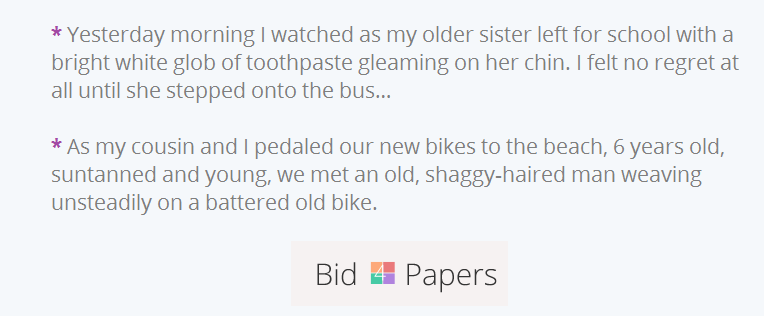
Remember that most essay assignments don’t allow to write from the first person. Be sure to check the requirements before using “I” in your writing.
5) Personal Stories
This hook is perfect for personal narratives or college application essays, though you would hardly use it for argumentative or too formal persuasive papers. Ask your professor if you can use personal pronouns in your writing, and hook readers with a personal story which not necessarily should be yours.
You can tell the story of your friend, relative, or president. Why not, after all?
Examples:
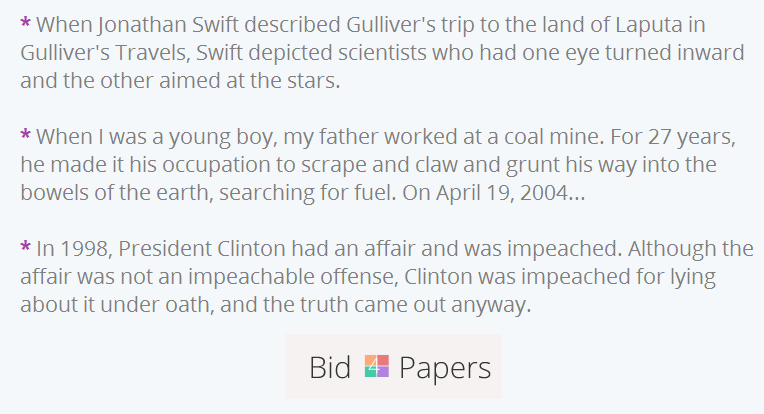
But please, don’t start your essay with a hook like “I was thinking about what to write for this essay and came up with this.”
Teachers hate it! Sure, this hook is better than no hook at all, but it will never distinguish your work from the crowd.
6) Statistics
Use statistical data to hook readers with new facts they might not have been known. Be sure to include the source.
Examples:
- “People lie in 1 out of 5 conversations lasting more than 10 minutes, according to Allison Komet from the Psychology Today magazine.”
- “70% of all jobs found today were got through different networking strategies.”
- “Fifty percent of marriages end up in divorce.”
- “The average iceberg weighs over 100,000 metric tons.”
Do research to find data on your topic. Refer to sources your teacher would consider reliable.
7) Questions
This type of hooks can help you create a reader’s personal interest in your essay and wish to continue reading it. But don’t make your question too general.
Let’s say you write an essay about smartphones. Asking a question a la “Do you have a smartphone?” will hardly grab readers’ attention because it doesn’t engage them in critical thinking.
So, try to avoid questions expecting simple Yes or No answers.
Examples:
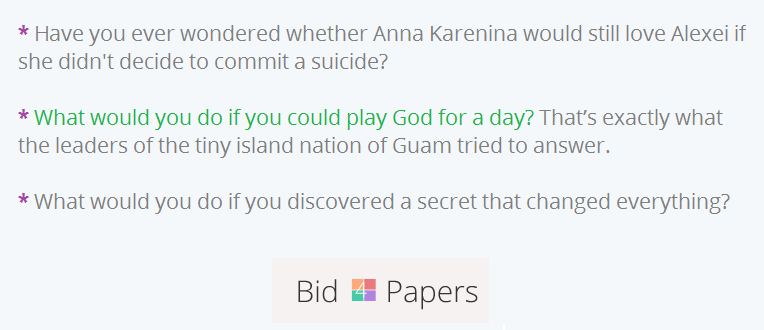
Rhetorical questions could be a good idea for essay hooks.
As well as quotes from famous people, they are easy to create and, therefore, overused too. You’ll need to wind up your brain to impress a reader and make that question catchy.
8) Fact/Definition
This hook can surprise a reader with something they might not have known. Interesting facts about what you are going to discuss in your essay will intrigue your audience and make them want to learn more.
Examples:
- “Spain, though hardly a literary juggernaut, translates more books in one year than the entire Arab world has in the past one thousand years.”
- “Amiable is the best way to describe Elizabeth’s personality: she was friendly and caring.”
Be careful with definitions! Your professor will hardly like your essay opening if you copy it from a dictionary. So, if you decide to start an essay with a definition related to your topic, avoid something like this:
- “Webster’s Dictionary defines ‘truth’ as ‘the state of being the case; factual; the body of real things, events, and facts’.”
A bold pronouncement, outrageous statement, or exaggeration will help you hook readers, too.
Examples:
- “If you say you’ve never told a lie, then you’re lying.”
- “Cigarettes are the primary cause of cancer.”
- “If the government cuts any more money from education, the entire country will crumble.”
9) Scenes
People are visually-oriented. Depending on the type and length of your essay, “draw” a scene in your hook to help readers “see” a clear picture in mind.
Decide on a scene that would appeal to senses and set the mood for your essay.
Examples:
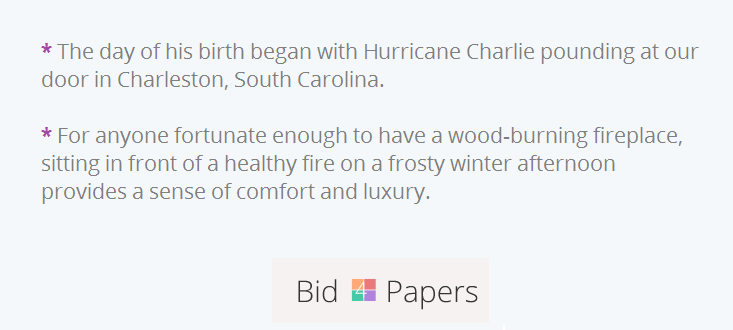
10) Thesis Statement
There is no harm in getting right to the point. Start with your argument and support your point of view throughout the essay. If you have an interesting take on a subject, readers will want to see where you came up with your idea.
Examples:
- “It is time to reveal the truth about Thanksgiving, and the truth is that Thanksgiving is not such a terrific holiday…”
- “Humans need to invest more time and money into space exploration because Earth is on a certain path to destruction.”
So many hooks, so many essays. The logical question appears: how do you know what type of openings in the introduction would fit your paper best?
Well, you might ask our writers to help you or continue reading this post to get more tips on writing hooks for your essay.
How to Choose a Good Hook for Your Essay
With so many types of essay hooks, you wonder how to choose the right one for your particular paper. The problem is, there’s no single formula here. To know what hook to consider, keep in mind the following:
- Your audience
- Your essay type
Depending on who reads your essay, one and the same message will speak in different ways to them.
It’s clear that a hook you use to attract a college girl would hardly help you spark the interest of a college admission counselor. So, the first question to answer before going on the writing road is:
- Who is my audience? Whom do I want to target with my essay?
Then, try to figure out what matters to your readers and what they expect to get from the essay.
- Do they read it to solve a problem?
- Do they want to learn interesting facts about you?
- Do they need distinctive information on the topic?
- Do they want to see that you understand a subject?
Once you’ve nailed it down, you’ll know what types of hooks will work for this particular writing.

Source: Giphy
The type of hooks that would fit your paper best depends on the essay type, either.
For example, anecdotes don’t work for writing a critical précis, but they would catch readers of dialectic essays. Quotes and questions are perfect hooks for novel critiques or persuasive essays, while facts or statistics fit argumentative essays best.
Don’t start your essay with a great hook simply because it’s great. It should be relevant to your topic, thesis, and purpose of your paper.
Questions to answer before choosing an essay hook:
- How do I want my readers to feel?
- What do I want my readers to learn?
Depending on feelings you want to evoke, an essay hook may be some shocking statistics, a romantic personal story, a funny anecdote, a motivational quote, etc.
Depending on the purpose of your writing, make an essay hook reflect it. Common misconceptions or outrageous statements may encourage readers to learn something new, while catchy questions would engage in critical thinking or motivate.
7 Tips for Writing a Great Hook
Sometimes an amazing attention grabber will come to you in a flash of inspiration. Other times, coming up with hook ideas can put your writing skills to the test. If you’re lacking inspiration for a good hook, follow this step-by-step guide to crafting a great hook.
- Your title is your first hook. As crucial as your opening sentence is, remember that you have one opportunity to hook your reader before they open your book or click on your article: your title. Even before your first sentence, your title is your earliest opportunity to grab readers’ attention. Your title is like a mini hook. Think of how you can interest your target audience with emotionally loaded language or surprising combinations of words.
- Drop your readers into the middle of the action. A classic hook strategy is to start with an action-packed or climactic event. This method hooks your reader in two ways: first, with the energy of the scene itself. And second, by dropping your reader into the middle of the story without context, you’ll leave them with questions that will compel them to keep reading. In literary terms, starting in the middle of a narrative is called in medias res, and it’s a simple way to create intrigue. There are a few ways to make this hook work with the rest of your narrative: You can make your hook into a prologue or flashforward, and then begin writing in chronological order, or you can continue writing in a non-linear fashion.
- Form an emotional connection. If your piece isn’t action-packed, you might consider hooking your reader with an emotional scene. Showing a character’s intense emotional response on the first page can help you tap into your reader’s sense of empathy, rather than their desire for thrills. If your reader can develop an emotional connection with your character(s) early on, they’ll be more interested in what happens to them later. One technique that works especially well for informative and argumentative essay hooks is to start with a personal story. This emotional appeal can make readers feel more connected to an otherwise dry or fact-heavy piece of writing.
- Make a surprising statement. Starting your piece with a controversial or unexpected statement will encourage your audience to keep reading, as they anticipate how you’ll prove your statement. A thematic statement can also serve as a lens through which the audience sees the rest of your piece. Like the thesis statement of an academic paper, a statement hook will have your readers searching for connections for the rest of the book. A classic example is the opening line of Jane Austen’s Pride and Prejudice (1813): “It is a truth universally acknowledged, that a single man in possession of a good fortune, must be in want of a wife.” This statement frames the rest of the novel, enticing readers without introducing any characters or setting.
- Leave your reader with questions. Most techniques to hook a reader have one thing in common: They force the reader to ask questions. A good hook—whether it uses action, emotion, a strong statement, or another technique—will have your reader guessing about your characters’ motivations, backstories, and more. Maybe in high school, you learned to start an essay with a rhetorical question. Try that same technique now, but leave the actual question out of the finished piece. Instead, set up a scene that leads your reader to come up with the question on their own.
- Stay away from description. You don’t have many pages to hook your reader, so be wary of long descriptive passages that don’t generate questions. Don’t feel the need to explain every little thing to your reader—leaving some questions unanswered will create suspense, and you can fill in details later. Focus on the important information: A long description of your main character’s physical features probably isn’t the best choice for your first paragraph, unless those features have a mysterious backstory.
- Once you have your reader’s attention, keep it. Writing a great hook will get your reader’s attention, but if you leave them with lots of unanswered questions, they’ll just become frustrated. To sustain your reader’s attention, make sure to answer at least some of the questions posed in your hook fairly early on, while keeping some information for later. One technique, especially useful in thrillers, is to introduce a new question every time you answer a previous one, keeping your reader in constant suspense. For works with multiple chapters, don’t let your first chapter be the only one with a hook. Try opening each chapter with a teaser—an action, a bit of dialogue, or an interesting fact that will grab the reader’s attention—to maintain your reader’s focus throughout a longer piece.
Conclusion
A hook is typically the first one or two sentences of an essay or article that is designed to grab the reader’s attention. Much like a fish gets literally hooked by bait, the hook of an essay should captivate your audience and make them want to read more.
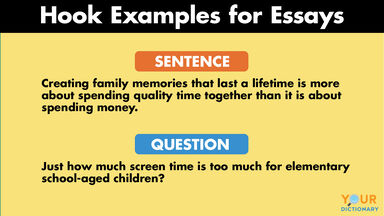
nice article , Thanks for sharing , checkout my work on rhetorical Precis .